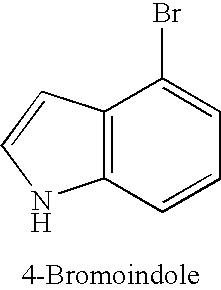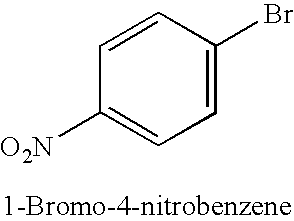Process for catalytically preparing aromatic or heteroaromatic nitriles
a technology of aromatic or heteroaromatic nitrile and catalytically preparing process, which is applied in the direction of washstands, scaffold accessories, light support devices, etc., can solve the problems of process disadvantage, process is not practicable, and ammoxidation fails, so as to improve the process of cyanating haloaromatics
- Summary
- Abstract
- Description
- Claims
- Application Information
AI Technical Summary
Benefits of technology
Problems solved by technology
Method used
Image
Examples
examples
[0041]General Procedure:
[0042]In an autoclave, 1 equiv. of aryl halide or heteroaryl halide, 2 equiv. of 1-alkylimidazole, 0.1 equiv. of CuI, 0.2 equiv. of dried K4[Fe(CN)6] (potassium hexacyanoferrate(II)), tetradecane as an internal standard for the GC analysis and a suitable amount of toluene were combined under argon and heated to 160° C. (The K4[Fe(CN)6] was dried by heating powdered K4[Fe(CN)6]x3H2O in a vacuum of ≦1 mbar to 80° C. for at least 24 hours.) After 16 hours, the reaction mixture was cooled to room temperature. Conversion and yield were determinable by means of gas chromatography. An isolation of the product took place according to the customary workup (distillation, crystallization or chromatography).
TABLE 1Copper-catalysed cyanation with potassium hexacyanoferrate(II) in thepresence of 1-alkylimidazoles.Yield of productExamplenitrile [%]No.Ar—X(additive)1.49(1-Butylimidazole)2.50(1-Methylimidazole)3.80(1-Butylimidazole)4.55(1-Methylimidazole)5.66 (180° C.);(1-Met...
PUM
| Property | Measurement | Unit |
|---|---|---|
| Temperature | aaaaa | aaaaa |
| Temperature | aaaaa | aaaaa |
| Temperature | aaaaa | aaaaa |
Abstract
Description
Claims
Application Information
 Login to View More
Login to View More - R&D
- Intellectual Property
- Life Sciences
- Materials
- Tech Scout
- Unparalleled Data Quality
- Higher Quality Content
- 60% Fewer Hallucinations
Browse by: Latest US Patents, China's latest patents, Technical Efficacy Thesaurus, Application Domain, Technology Topic, Popular Technical Reports.
© 2025 PatSnap. All rights reserved.Legal|Privacy policy|Modern Slavery Act Transparency Statement|Sitemap|About US| Contact US: help@patsnap.com



